- There are no more items in your cart
- Shipping Calculated at checkout
- Sub-Total (inc. VAT) £0.00
Need Help?
Swimming Pool and Leisure Centre Paints
Specialist Swimming Pool and Leisure Centre Paints are designed to meet the rigorous demands of aquatic environments, providing exceptional durability, chemical resistance, and adherence to stringent health and safety standards. These paints are ideal for use in public and private pools, leisure centres, and spas, offering long-lasting protection, aesthetic enhancement, and compliance with industry regulations. Available in a variety of finishes and colours, these coatings ensure a safe, visually appealing environment that withstands the challenges of constant water exposure, UV rays, and heavy foot traffic. Click to see more info.
Subcategories
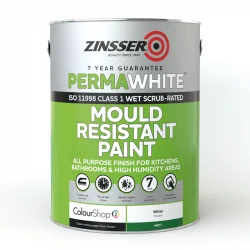
Zinsser Perma-White Interior
Available in 4,400+ matt and satin colours. Suitable for use on interior walls, ceilings, trim, doors, and more. Prevents mould and mildew growth on the paint film for up to 5 years. Self-priming with excellent adhesion to glossy and hard-to-paint surfaces. Durable, washable, moisture-resistant finish that resists dirt pickup. Low...

Teamac Chlorvar Chlorinated Rubber Paint
2,400+ colours. Durable, chlorinated rubber coating. Ideal for high-resistance protective finishes. For metal, concrete, and wood surfaces. Robust chemical and water resistance. Superior resistance to saltwater, chemicals, and acids.Buy A Paint Colour Sample
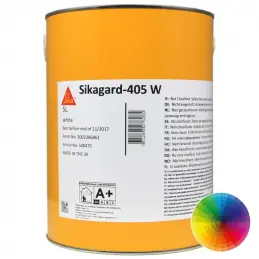
Sikagard 405 W - Colours
A single component waterborne acrylic resin based topcoat or stand alone coating for internal walls and ceilings in 9 colours - concrete, bricks, cement based and gypsum substrates, metallic surfaces, timber, tiles and plastic. Suitable for pharmaceutical, medical engineering, food & beverage industry and more.Good resistance to...
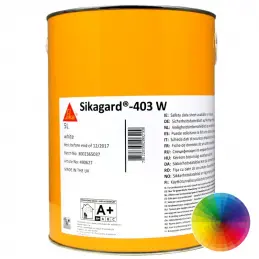
Sikagard 403 W - Colours
A single component, waterborne modified acrylic resin based intermediate and surface coating in 9 colours, containing an antimicrobial additive. Seamless, easy to clean finish Good resistance to repeated cleaning regimes using mild detergents and cleaning solutions Tough and highly durable Good water vapour permeability More flexible...

Coo-Var Swimming Pool Paint
In 4 glossy colours. Chlorinated rubber coating. Ideal for new concrete swimming pools, previously chlorinated rubber painted surfaces, and other substrates.
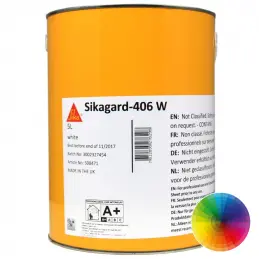
Sikagard 406 W - Colours
A single component waterborne acrylic resin based surface coating in 9 colours, used as a topcoat or standalone coating for: internal walls and ceilings for concrete, bricks, cement based and gypsum substrates, metallic surfaces, timber, tiles and plastic. Suitable for pharmaceutical, medical engineering and food & beverage industry....
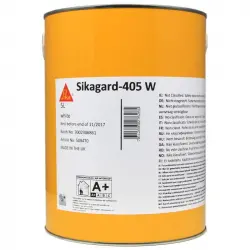
Sikagard 405 W - White
Topcoat or stand alone coating for internal walls and ceilings - concrete, bricks, cement based and gypsum substrates, metallic surfaces, timber, tiles and plastic. Suitable for pharmaceutical, medical engineering, food & beverage industry and more.Single component white, waterborne acrylic resin based coating containing an organic...
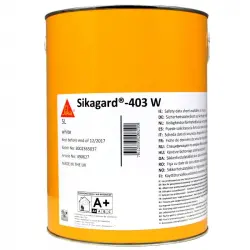
Sikagard 403 W - White
Single component seamless, easy to clean finish with good resistance to repeated cleaning regimes using mild detergents and cleaning solutions.Waterborne modified acrylic resin based intermediate and surface coating, containing an antimicrobial additive. Tough and highly durable. Good water vapour permeability. More flexible in...
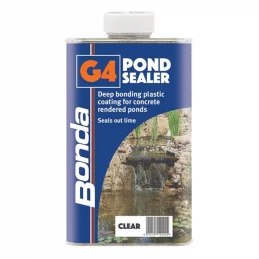
Bonda G4 Pond Sealer Clear
Bonda G4 Pond Sealer Clear is a moisture-cured polyurethane, which forms a non-porous seal on concrete, brick or porous stone. G4 uses the moisture in the air and substrate to cure or harden. It can be applied onto slightly damp substrates.Deep bonding plastic coating for concrete rendered ponds Seals concrete floors - Quick and easy to...

Coo-Var Squash Court Paint
Matt white paint designed for high-wear areas. For non-playing surfaces of squash courts, including walls and surrounds. Durable, high-opacity, impact-resistant. For interior use.
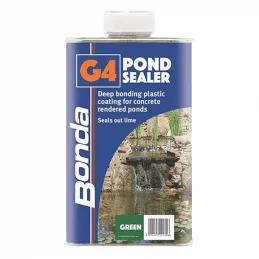
Bonda G4 Pond Sealer Colours
Bonda G4 Pond Sealer Colours is a moisture-cured polyurethane, which forms a non-porous seal on concrete, brick or porous stone. G4 uses the moisture in the air and substrate to cure or harden.Please note: G4 Pond Sealer Colours must be applied over two coats of Bonda G4 Pond Sealer Clear Used in conjuction with G4 Damp Seal for coloured...
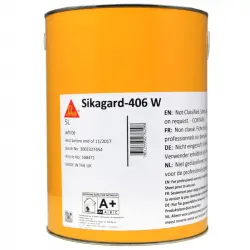
Sikagard 406 W - White
Sikagard 406 W is a single component white, waterborne acrylic resin based surface coating containing an organic in film preservative with a mat finish. Topcoat or standalone coating for: internal walls and ceilings for concrete, bricks, cement based and gypsum substrates, metallic surfaces, timber, tiles and plastic. Suitable for...
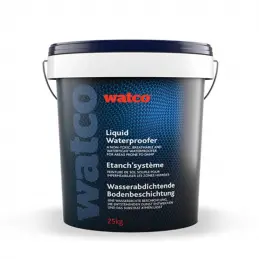
Watco Liquid Waterproofer
Watco Liquid Waterproofer is a thoroughly effective solution for damp and wet areas. The thick, roller applied coating can be used in basements, underground garages, workshops or any areas where rising damp or water ingress is a problem.Resistant to frost and salt attack Hardwearing – high abrasion resistance Creates a tough textured...
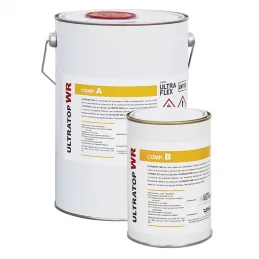
Eagle Ultratop WR
Eagle Ultratop WR is a two-component aliphatic polyurethane resin used for coating and protection of Ultraflex aromatic liquid polyurethane membrane for high traffic or total immersion. Once applied, it forms a flexible film with excellent adhesion and mechanical properties. Available in Black, White, Dark Grey, Light Grey &...
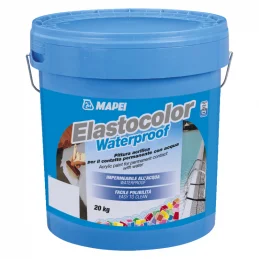
Mapei Elastocolor Waterproof
A flexible, protective paint for outdoor applications made from acrylic resin in water dispersion and is perfectly compatible as a coloured finishing coat with Mapelastic, Mapelastic Smart and Triblock Finish. Application examples include:Painting general cementitious substrates to form a protective coat resistant to contact with water...
Need Help?
Need Help?
Swimming Pool and Leisure Centre Paints are essential for maintaining the safety, durability, and visual appeal of aquatic facilities. These specialist coatings are specifically formulated to withstand the unique challenges of environments where water, chemicals, and constant use are a daily reality. Whether applied to public swimming pools, private leisure centres, spas, or water parks, these paints play a critical role in ensuring that surfaces remain resilient, hygienic, and compliant with industry standards.
Understanding Swimming Pool and Leisure Centre Paints
Swimming Pool and Leisure Centre Paints are high-performance coatings engineered to provide long-term protection and aesthetic appeal in environments subjected to continuous water exposure, chemical treatments, and UV radiation. These paints are not only designed to adhere securely to various substrates—such as concrete, fibreglass, metal, and previously painted surfaces—but also to maintain their integrity and colour over time. Given the stringent health and safety standards required in these settings, these paints must also resist the growth of algae, mould, and bacteria, all while being easy to clean and maintain.
The paints used in swimming pools and leisure centres must meet rigorous performance criteria. They are available in a range of formulations, including epoxy, chlorinated rubber, acrylic, and polyurethane-based paints, each offering distinct benefits depending on the application. The choice of paint depends on various factors, including the type of surface, the pool's location (indoor or outdoor), and the specific environmental conditions to which the paint will be exposed.
Key Features and Benefits of Swimming Pool and Leisure Centre Paints
When selecting swimming pool and leisure centre paints, it’s essential to consider features that ensure optimal performance, safety, and longevity in aquatic environments. These features not only determine the effectiveness of the paint but also contribute to the numerous benefits that enhance the facility's overall function and aesthetic appeal.
Chemical Resistance and Long-Lasting Protection
Swimming pool paints must be highly resistant to chemicals like chlorine, bromine, and other agents commonly used in pool water. This chemical resistance is crucial to prevent the paint from deteriorating quickly, ensuring that the surface remains intact and the environment stays safe and clean. This durability translates into long-lasting protection against water, chemicals, and physical wear. The result is a coating that reduces the need for frequent repainting and repairs, saving both time and money over the life of the paint.
UV Stability and Aesthetic Appeal
For outdoor pools and leisure facilities, UV stability is a critical feature. Prolonged exposure to sunlight can cause non-UV-stable paints to fade, peel, or crack, compromising the pool’s appearance and structural integrity. UV-stable paints help preserve the colour and finish of the coating, ensuring the facility remains visually appealing over time. This contributes significantly to the aesthetic appeal of the pool area, which can enhance the overall user experience. With a wide range of colours and finishes available, facility managers can create a custom look that complements the design of the facility, whether it's a classic blue pool or a modern, unique space.
Waterproofing and Improved Hygiene
Effective waterproofing is fundamental in any aquatic environment. Waterproof paints create a barrier that prevents water from penetrating the substrate, protecting the underlying structure from damage and reducing the risk of mould and mildew growth. This feature is essential not only for maintaining the structural integrity of the pool but also for improving hygiene. High-quality swimming pool paints resist algae, mould, and mildew, which are common in wet environments and can compromise both safety and appearance. These paints are easy to clean and maintain, ensuring that the pool area remains sanitary and inviting for all users.
Slip Resistance and Enhanced Safety
Safety is a paramount concern in swimming pools and leisure centres. Slip-resistant paints incorporate fine aggregates or other additives to create a textured surface that reduces the risk of slips and falls, particularly in high-traffic areas such as pool decks and changing rooms. This feature is critical in maintaining a safe environment, which is a top priority in any aquatic facility. Some swimming pool paints also offer anti-microbial properties, further enhancing safety by inhibiting the growth of harmful bacteria and mould. These combined features contribute to a healthier environment, ensuring that the facility is both safe and user-friendly.
Ease of Application and Cost-Effectiveness
The ease with which the paint can be applied is an important consideration, especially for large or complex surfaces. Paints that can be applied by brush, roller, or spray offer versatility and convenience, while those with fast drying times help to minimise downtime during application. This ease of application, coupled with the durability of high-quality swimming pool paints, leads to cost-effectiveness. While specialist paints may represent a higher initial investment compared to standard options, their long-term durability and resistance to damage mean fewer repaints and lower maintenance costs over time, making them a smart financial choice for any aquatic facility.
Substrate Compatibility and Versatility
The selected paint must be compatible with the specific substrate, whether it’s concrete, fibreglass, or metal, to ensure a long-lasting bond and effective protection. This compatibility is crucial for avoiding issues like peeling, cracking, or poor adhesion, which can lead to costly repairs. Furthermore, these paints are highly versatile, suitable for use in a variety of aquatic environments beyond swimming pools, including spas, fountains, water parks, and gymnasium wet areas. This versatility ensures that all areas of a facility, regardless of their specific needs, are protected and enhanced by durable, water-resistant coatings.
Environmentally Friendly Formulations and Compliance with Regulations
With growing awareness of environmental impact, many swimming pool paints are now formulated with low VOC (volatile organic compounds) content, making them safer for both the environment and human health. Eco-friendly paints contribute to cleaner air quality and reduce the environmental footprint of the facility. Additionally, these paints are often designed to meet or exceed industry health and safety standards, ensuring compliance with local building codes and regulations. This compliance is crucial for avoiding penalties and ensuring the safety of all users, making these paints not only a responsible choice but also a practical one for long-term facility management.
Common Uses of Swimming Pool and Leisure Centre Paints
Swimming Pool and Leisure Centre Paints are essential for a broad range of aquatic environments and associated facilities. From public and private pools to specialised areas like gyms, saunas, changing rooms, and kitchens, these paints must meet the diverse demands of durability, safety, hygiene, and aesthetics. The following is an expanded overview of how these paints are used across various settings, including pools, walls, ceilings, and other critical surfaces within leisure and sports facilities.
Public Swimming Pools
Public swimming pools are high-traffic environments that demand robust, durable coatings. These pools are typically open year-round and exposed to hundreds of users daily, necessitating paints that can withstand constant exposure to chlorinated water, intense UV radiation, and rigorous cleaning regimes.
Pool Surfaces: The interior surfaces of public pools are often coated with epoxy-based or chlorinated rubber paints, which provide exceptional chemical resistance and longevity. These paints prevent the growth of algae and mildew, ensuring that the pool remains safe and hygienic. The chosen colours, typically light blue or white, are not just aesthetically pleasing but also enhance water clarity, making it easier to see swimmers below the surface.
Walls and Ceilings in Adjacent Areas: The surrounding areas, such as locker rooms, changing rooms, and poolside corridors, require paints that are resistant to moisture, mildew, and frequent cleaning. For example, high-performance acrylic or epoxy coatings are often applied to walls and ceilings to protect against dampness and mould growth. These paints are easy to clean and maintain, essential in public facilities where hygiene is critical. Additionally, the ceilings above the pool and in adjacent areas are often painted with reflective, light-coloured paints to improve visibility and create a bright, welcoming atmosphere.
Non-Slip Deck Coatings: The safety of swimmers is paramount, especially in high-traffic areas around the pool deck. Non-slip paints or coatings with added grit are applied to walkways and steps to reduce the risk of slips and falls. These coatings are typically durable enough to withstand heavy foot traffic and the wear and tear from pool furniture and cleaning equipment.
Private Leisure Pools
Private leisure pools, whether in residential settings or luxury hotels, combine the need for durability with an emphasis on aesthetics and comfort. The choice of paint here can significantly enhance the ambiance of the pool area.
Custom Colours and Finishes: In these settings, the paint can be customised to match the surrounding decor or landscape. High-gloss or satin finishes are popular choices, providing a sleek, polished look that enhances the luxury feel of the space. In some cases, decorative paints or special effects, such as metallic sheens or textured finishes, are used to create unique visual elements.
Walls and Ceilings: The walls and ceilings surrounding private leisure pools are often painted with moisture-resistant, anti-mould coatings that maintain their appearance despite the humid environment. These paints help prevent the formation of mildew and ensure that the luxury aesthetic is preserved over time. Colours are often chosen to create a serene, relaxing atmosphere—think soft blues, warm earth tones, or even bold, dramatic hues that make a statement.
Poolside Kitchens and Lounges: Adjacent facilities, such as poolside kitchens and lounges, require paints that are not only moisture-resistant but also durable enough to withstand spills, stains, and frequent cleaning. Anti-graffiti coatings might be used in these areas to allow for easy removal of stains or marks, ensuring that the space remains pristine.
Spa and Jacuzzi Areas
Spas and jacuzzis are specialised environments that demand paints capable of withstanding high temperatures, moisture, and frequent exposure to chemicals such as bromine.
Surface Coatings: The interiors of spas and jacuzzis are typically coated with epoxy-based paints, which are known for their strong adhesion and resistance to heat and chemicals. These paints ensure that the surfaces remain smooth and free from cracks or peeling, providing a comfortable, luxurious experience for users. The colours chosen are often soothing and natural, such as soft greens, warm beige, or calming blues, contributing to the overall ambiance of relaxation.
Walls and Ceilings: In spa environments, the walls and ceilings are subjected to high humidity and steam, particularly in areas like saunas and steam rooms. Heat-resistant paints are used to prevent warping, peeling, or bubbling, while anti-mould properties ensure that the surfaces remain clean and hygienic. In saunas, where temperatures can soar, specialised paints that can withstand extreme heat are essential to prevent damage and maintain a safe environment.
Anti-Slip Solutions: Around spa pools and jacuzzis, non-slip coatings are applied to the floors to enhance safety, especially where water can create slippery conditions. These coatings not only provide a secure footing but also complement the luxurious feel of the space with finishes that range from natural stone looks to more contemporary designs.
Wave Pools
Wave pools are dynamic environments where the combination of water movement, chlorination, and UV exposure creates a unique set of challenges for paints.
Durability and Flexibility: The intense forces generated by artificial waves require paints that are exceptionally durable and flexible. Chlorinated rubber-based paints are often chosen for their ability to adhere to various substrates, including concrete and fibreglass, and their resistance to the stresses of constant water movement. These paints must also be UV-resistant to prevent fading and deterioration due to prolonged exposure to sunlight.
Splash Zones and Surrounding Areas: The walls and ceilings in areas adjacent to wave pools, such as splash zones and wave generators, are typically coated with waterproof, mildew-resistant paints that can withstand the humid, splash-prone environment. These paints are easy to clean and maintain, ensuring that the facility remains safe and visually appealing.
Safety Coatings: Non-slip coatings are crucial in areas where water is constantly in motion, such as around the pool’s edge and in walkways leading to the wave pool. These coatings help prevent slips and falls, which are especially important in family-friendly environments where children are present.
Toddler Pools and Play Areas
Toddler pools and adjacent play areas are designed with the safety and enjoyment of young children in mind. These environments require paints that are not only durable but also safe and engaging.
Non-Toxic, Safe Coatings: The paints used in toddler pools must be non-toxic and free from harmful chemicals, ensuring that they are safe for young children who may come into close contact with the surfaces. Rubberized or acrylic-based paints are commonly used for their durability and safety features. These paints are also slip-resistant, providing an additional layer of safety for children who may be running or playing around the pool.
Bright, Engaging Colours: To create a fun and inviting atmosphere, the paints used in toddler pools often come in bright, cheerful colours such as yellows, reds, and blues. These colours not only appeal to children but also help to visually differentiate shallow areas, making it easier for parents and lifeguards to monitor the safety of young swimmers.
Walls and Ceilings in Play Areas: The surrounding play areas, including walls and ceilings, are typically coated with moisture-resistant, washable paints. These surfaces often need to withstand the wear and tear of active play, including impacts from toys and play equipment. Antimicrobial paints are also used to reduce the spread of germs, ensuring a clean and healthy environment for children.
Bathing Pools and Thermal Spas
Bathing pools and thermal spas are environments where the focus is on relaxation and therapeutic benefits. The paints used here need to withstand constant exposure to water, heat, and minerals, particularly in natural or mineral-rich baths.
Mineral-Resistant Coatings: The surfaces of bathing pools and thermal spas are often exposed to high mineral content in the water, which can cause staining and degradation over time. Specialised epoxy or polyurethane paints are used to protect these surfaces from mineral deposits while maintaining a smooth, attractive finish. These paints are also resistant to the higher temperatures often found in thermal spas, ensuring that they do not blister or peel.
Therapeutic Colours and Finishes: The colour palette for thermal spas and bathing pools typically includes soothing, natural tones like soft blues, greens, or earth tones, which promote a calming environment. In some cases, the paint may include subtle texture or decorative elements that enhance the spa’s ambiance, such as a faux stone or marble effect.
Adjacent Relaxation Areas: The walls and ceilings in relaxation areas surrounding the pools are often painted with moisture-resistant, anti-mould coatings. These paints help maintain a serene and hygienic atmosphere, essential for a spa environment. Reflective or light-diffusing finishes might be used to create a tranquil, well-lit space that enhances the overall spa experience.
Gymnasium Wet Areas and Sports Facilities
Gymnasium wet areas, such as showers, locker rooms, and saunas, as well as broader sports facilities, demand paints that can handle high levels of moisture, frequent cleaning, and physical wear and tear.
Moisture-Resistant and Anti-Microbial Coatings: The walls and ceilings in wet areas like showers and locker rooms are coated with moisture-resistant paints that prevent mould and mildew growth. These areas often see high levels of humidity, and the paints used must be able to withstand this environment without deteriorating. Antimicrobial paints are particularly important in these settings to ensure that the surfaces remain hygienic and free from bacteria.
Durability in High-Traffic Areas: In gymnasiums and sports facilities, durability is key. The floors, walls, and ceilings in these areas are often subjected to intense use, whether from heavy gym equipment, constant foot traffic, or high-impact sports. Epoxy or polyurethane-based paints are commonly used for their durability and resistance to scuffing, scratching, and staining. These paints are also easy to clean, ensuring that the facility remains presentable and functional despite heavy use.
Non-Slip Surfaces: Safety is a priority in gym and sports facilities, particularly in areas where water might be present, such as around indoor pools or in locker rooms. Non-slip coatings are applied to floors to prevent accidents, providing a secure surface even when wet.
Reflective Pools and Architectural Water Features
Reflective pools and architectural water features are designed to create stunning visual effects, often serving as focal points in public spaces, corporate buildings, or luxury hotels.
High-Gloss, Reflective Coatings: The interior surfaces of reflective pools are typically coated with high-gloss paints that enhance the mirror-like quality of the water. These paints are chosen for their ability to reflect surrounding architecture and landscapes, creating a striking visual impact. Dark colours, such as deep blues, blacks, or greys, are often used to maximise the reflective properties of the pool.
Surrounding Walls and Ceilings: In the areas surrounding reflective pools, such as in lobbies or courtyards, walls and ceilings are often painted with UV-resistant and moisture-resistant coatings. These paints are selected not only for their durability but also for their ability to complement the reflective pool, often in neutral or muted tones that allow the water feature to take centre stage.
Maintenance and Durability: Reflective pools and water features require paints that are easy to maintain and resistant to environmental factors such as algae growth, UV exposure, and water chemistry. The chosen paints must be durable enough to maintain their appearance over time, ensuring that the feature continues to provide a dramatic visual effect.
Therapy Pools and Rehabilitation Areas
Therapy pools used for hydrotherapy or rehabilitation are specialised environments where the paints must ensure safety, comfort, and resistance to specific conditions such as warm water and chemical exposure.
Comfortable, Safe Coatings: The surfaces of therapy pools are often coated with rubberized or soft-touch paints that provide a comfortable, non-abrasive surface for users. These paints are resistant to the higher temperatures and specific chemicals used in hydrotherapy, ensuring that the coating remains intact and safe for use.
Anti-Microbial Walls and Ceilings: In therapy and rehabilitation areas, hygiene is of utmost importance. Antimicrobial paints are applied to walls and ceilings to prevent the growth of bacteria, mould, and mildew. These paints are easy to clean and maintain, providing a safe environment for patients undergoing therapy.
Soothing Aesthetic: The colours used in therapy pools and surrounding areas are typically soft and calming, such as pastel blues, greens, or warm neutrals. These tones contribute to a healing environment, promoting relaxation and comfort for patients.
Infinity Pools and Luxury Water Features
Infinity pools, known for their vanishing edge design, require paints that enhance the seamless visual effect of the water merging with the horizon.
High-Gloss, Seamless Coatings: The interior surfaces of infinity pools are typically coated with high-gloss epoxy or polyurethane paints that provide a smooth, reflective surface. These paints are carefully selected to maintain the integrity of the vanishing edge, ensuring that the illusion of the pool extending into the landscape is preserved.
Surrounding Luxury Spaces: The walls and ceilings of adjacent luxury areas, such as poolside lounges or dining spaces, are often treated with high-quality, moisture-resistant paints that complement the pool’s design. Decorative finishes, such as metallic sheens or pearlescent effects, can be used to enhance the overall luxury experience.
UV and Weather Resistance: Infinity pools, often located outdoors in picturesque settings, are exposed to intense sunlight and varying weather conditions. The paints used must be highly UV-resistant to prevent fading and deterioration, ensuring that the pool maintains its striking appearance over time.
Natural Swimming Pools and Eco Pools
Natural swimming pools, designed to mimic natural bodies of water, require eco-friendly paints that do not interfere with the biological processes within the pool.
Environmentally Safe Coatings: The paints used in natural swimming pools must be low in VOCs (volatile organic compounds) and free from harmful chemicals to ensure that they do not disrupt the pool’s ecosystem. These coatings are typically resistant to algae and UV rays, maintaining the pool’s natural aesthetic while providing a safe, sustainable swimming environment.
Blending with Nature: The walls and ceilings of nearby structures, such as pavilions or pool houses, are often painted with eco-friendly paints that blend seamlessly with the natural surroundings. Earth tones and muted greens are popular choices, helping the structures integrate into the landscape without detracting from the natural beauty of the pool.
Durability and Maintenance: Although natural swimming pools emphasise ecological balance, the paints used must still be durable and easy to maintain. These coatings are designed to withstand the environmental challenges typical of outdoor settings, ensuring that the pool remains both beautiful and functional.
Swimming Pool and Leisure Centre Paints play a crucial role in ensuring the safety, durability, and aesthetic appeal of a wide variety of aquatic environments and associated facilities. From public swimming pools and private leisure areas to specialised settings like saunas, gyms, and natural swimming pools, these paints must be carefully selected to meet the unique demands of each space. By choosing the right type of paint for each application, facility managers and designers can create environments that are not only functional and safe but also visually stunning and inviting. This detailed overview highlights the importance of considering all aspects of the environment—whether it’s the pool itself, the surrounding walls and ceilings, or the adjacent activity areas—to ensure that the entire facility is protected and enhanced by the best possible paint solutions.
Frequently Asked Questions (FAQs)
What is the best type of paint for a concrete swimming pool?
For concrete swimming pools, epoxy-based or rubber-based paints are often recommended due to their excellent adhesion, durability, and resistance to chemicals and water. Epoxy paints are known for their long lifespan and toughness, while rubber-based paints offer more flexibility and ease of application.
How long does swimming pool paint typically last?
The lifespan of swimming pool paint depends on the type of paint and the conditions it is exposed to. Epoxy paints, for example, can last up to 7-10 years with proper maintenance, while rubber-based paints may need to be reapplied every 2-4 years. Factors such as UV exposure, water chemistry, and physical wear can all influence the longevity of the paint.
Can swimming pool paint be applied over existing paint?
Yes, swimming pool paint can be applied over existing paint, provided that the old paint is in good condition and properly prepared. Preparation may involve cleaning the surface, sanding to remove any loose or peeling paint, and applying a primer to ensure good adhesion of the new paint.
How long does it take for swimming pool paint to dry and cure?
Drying and curing times vary depending on the type of paint and environmental conditions. Most swimming pool paints require at least 24 hours to dry to the touch, but full curing may take several days to a week. It's important to follow the manufacturer's instructions and allow sufficient time for the paint to cure before refilling the pool or using the painted area.
Is it necessary to use a primer before applying swimming pool paint?
Using a primer is highly recommended, especially on porous surfaces like concrete. A primer helps to seal the surface, improve adhesion, and enhance the overall durability of the paint. Primers also provide a uniform base that can help achieve a smoother finish and reduce the number of topcoat layers needed.
What colours and finishes are available for swimming pool paints?
Swimming pool paints are available in a wide range of colours, from traditional blues and whites to more vibrant or custom shades. Finishes can vary from matte to high gloss, allowing for flexibility in achieving the desired aesthetic. Some paints also offer textured finishes for enhanced slip resistance.
How can I maintain the painted surface of my swimming pool?
To maintain the painted surface of your swimming pool, it's important to keep the water chemistry balanced, clean the pool regularly using appropriate cleaning solutions, and avoid using harsh chemicals that could damage the paint. Regular inspections and touch-ups as needed will also help to prolong the life of the paint.
Can I apply swimming pool paint myself, or should I hire a professional?
While it is possible to apply swimming pool paint yourself, especially for smaller or less complex projects, it requires careful preparation and the right tools. For larger or more challenging projects, hiring a professional may be advisable to ensure optimal results and to avoid potential mistakes that could compromise the paint's performance.
What is the difference between epoxy and rubber-based swimming pool paints?
Epoxy paints are known for their superior durability, long lifespan, and strong adhesion, making them ideal for concrete pools and other demanding environments. Rubber-based paints, on the other hand, are more flexible and easier to apply, but they may require more frequent reapplication. Both types have their advantages depending on the specific needs of the pool.
How do I choose the right swimming pool paint for my facility?
Choosing the right swimming pool paint involves considering factors such as the type of substrate, the pool's location (indoor or outdoor), the level of chemical exposure, and the desired aesthetic. Consulting with a technical expert can help you select the best paint for your specific needs and ensure a successful application.
Contact Technical Support
For further assistance in selecting the most suitable Swimming Pool and Leisure Centre Paint, or for advice on product compatibility and application techniques, contact the technical support team at Rawlins Paints. These specialist paints experts are available to guide you through the selection process, ensuring that you choose the right products for your facility's unique requirements.
